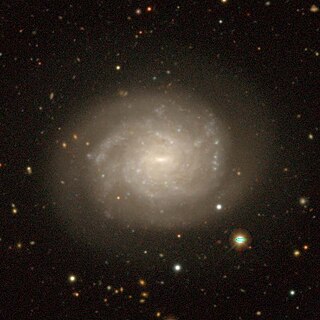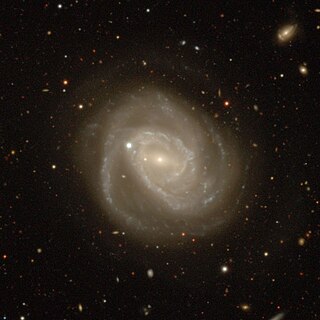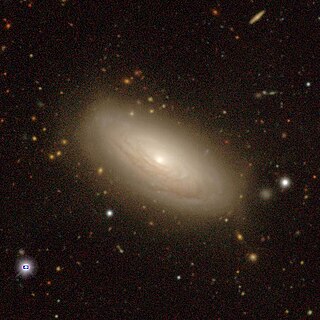
NGC 1365, also known as the Fornax Propeller Galaxy or the Great Barred Spiral Galaxy, is a double-barred spiral galaxy about 56 million light-years away in the constellation Fornax. It was discovered on 2 September 1826 by Scottish astronomer James Dunlop.

NGC 1532, also known as Haley's Coronet, is an edge-on barred spiral galaxy located approximately 50 million light-years from the Solar System in the constellation Eridanus. The galaxy was discovered by James Dunlop on 29 October 1826.

NGC 1637 is an isolated, non-interacting intermediate spiral galaxy in the constellation Eridanus, about a degree to the WNW of the star Mu Eridani. It was discovered by German-British astronomer William Herschel on 1 February 1786. It is located at a distance of about 9.77 ± 1.82 Mpc (31.9 ± 5.9 Mly) from the Milky Way. The galaxy is inclined at an angle of 31.1° to the line of sight from the Earth and the long axis is oriented along a position angle of 16.3°.

NGC 7714 is a spiral galaxy in the constellation Pisces. Its velocity with respect to the cosmic microwave background is 2430 ± 26 km/s, which corresponds to a Hubble distance of 116.9 ± 8.3 Mly (35.85 ± 2.54 Mpc). In addition, five non-redshift measurements give a distance of 92.24 ± 8.69 Mly (28.280 ± 2.664 Mpc). It was discovered by British astronomer John Herschel on 18 September 1830.

NGC 51 is a lenticular galaxy in the constellation Andromeda. It has a diameter of 90,000 light-years. The galaxy was discovered on September 7, 1885, by Lewis Swift, who described it as "Pretty faint, pretty small, round, brighter middle."

NGC 210 is a barred spiral galaxy located roughly 67 million light-years from the Solar System in the constellation Cetus. It was discovered on October 3, 1785 by William Herschel and later added to the New General Catalogue.

NGC 6845 is an interacting system of four galaxies in the constellation Telescopium. The cluster has certain similarities with Stephan's Quintet. Its distance is estimated to be about 90 Mpc.

NGC 3198, also known as Herschel 146 is a barred spiral galaxy in the constellation Ursa Major. It was discovered by William Herschel on 15 January 1788. NGC 3198 is located in the Leo Spur, which is part of the Virgo Supercluster, and is approximately 47 million light years away.

NGC 986 is a barred spiral galaxy in the southern constellation of Fornax, located about 76 million light-years away. It was discovered on August 5, 1826, by the Scottish astronomer James Dunlop, who described it as a "faint nebula, of an irregular round figure". The galaxy has an angular size of 3′.8 × 1′.9 with a visual magnitude of 10.9. It belongs to the Fornax Cluster of galaxies. This galaxy has a nearby companion, NGC 986A, at an angular separation of 17′, corresponding to a projected separation of 110 kpc. The two appear unconnected.

NGC 1403 is a lenticular or elliptical galaxy in the constellation Eridanus. It was discovered in 1886 by Francis Preserved Leavenworth. It was thought to be a "very faint, extremely small, nebulous star" by John Louis Emil Dreyer, the compiler of the New General Catalogue.

NGC 521, also occasionally referred to as PGC 5190 or UGC 962, is a barred spiral galaxy located approximately 224 million light-years from the Solar System in the constellation Cetus. It was discovered on 8 October 1785 by astronomer William Herschel.

NGC 1310 is a barred spiral galaxy located in the southern constellation of Fornax. It was discovered by English astronomer John Herschel on 22 October 1835.

NGC 782 is a barred spiral galaxy located in the constellation Eridanus about 160 million light-years from the Milky Way. It was discovered by British astronomer John Herschel in 1834.

NGC 1325 is a flocculent spiral galaxy situated in the constellation of Eridanus. Located about 75 million light years away, it is a member of the Eridanus cluster of galaxies, a cluster of about 200 galaxies. It was discovered by William Herschel on 19 December 1799.

NGC 7541 is a barred spiral galaxy located around 104 million light-years away in the constellation Pisces. It was discovered in 1785 by William Herschel, and it is 106,000 light-years across. NGC 7541 is known to have lots of star-forming regions.

NGC 1100 is a spiral galaxy located around 235 million light-years away in the constellation Eridanus. NGC 1100 is situated close to the celestial equator, and it was discovered on October 17, 1885, by Francis Preserved Leavenworth. NGC 1100 is not known to have much star formation, and is not known to have an active galactic nucleus.

NGC 1110 is a barred spiral galaxy located around 53 million light-years away in the constellation Eridanus. NGC 1110 was discovered on December 21, 1886 by the astronomer Francis Preserved Leavenworth, and has a diameter of 56,000 light-years. NGC 1110 is not known to have lots of star formation, and it is not known to have an active galactic nucleus.

NGC 1285 is a barred spiral galaxy in the constellation of Eridanus. Its velocity with respect to the cosmic microwave background is 5081 ± 12 km/s, which corresponds to a Hubble distance of 244.4 ± 17.1 Mly (74.94 ± 5.25 Mpc). However, three non-redshift measurements give a distance of 180.47 ± 3.24 Mly (55.333 ± 0.994 Mpc). It was discovered by Heinrich Louis d'Arrest on 28 October 1865.

NGC 1164 is a barred spiral galaxy located in the constellation Eridanus, approximately 60 million light-years from Earth. It was discovered by the astronomer John Herschel in 1834. NGC 1164 is classified as a (R')SAB(rs)b type spiral galaxy, with a prominent central bar structure and well-defined spiral arms.

NGC 1166 is a barred spiral galaxy located in the constellation Eridanus. It is situated approximately 53 million light-years away from Earth and was discovered by the British astronomer John Herschel on November 17, 1834.




















